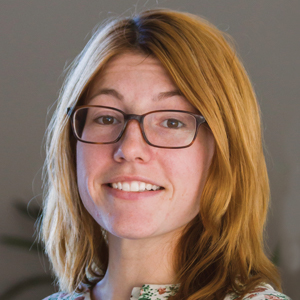Giving parasites their due
Parasitologist C.C. Wang might be in his 70s, but he still recalls the fever dream that plagued him during childhood illnesses. “I always had the same nightmare,” he says. “I was watching people slaughtering a hog and was badly shaken by its ear-piercing shrieking. The hog, covered with blood, suddenly struggled free and started to chase after me.”
Wang, an emeritus professor at the University of California, San Francisco, says his childhood bouts of malaria, typhoid and other infectious diseases shaped his future. “I was lucky to have survived them all,” he says. “The memories of these sufferings drove me into parasite research.”

These days, Wang is most recognized for applying biochemical analyses to parasitology. His approaches not only advanced our understanding of biology but helped bring about anti-parasitic drugs, including ivermectin, a treatment for river blindness and elephantiasis that was noted in the 2015 Nobel Prize for medicine.
Margaret Phillips was a doctoral student in Wang’s lab at UCSF, and now runs a parasitology research laboratory at the University of Texas Southwestern Medical Center at Dallas. She says that Wang always believed that working on parasites gave scientists important insights into biology and that his lab was always at the forefront of bringing molecular biology and biochemistry to parasitology.
In 2012, Wang and his wife, Alice, established an award recognizing scientists in the field of molecular parasitology that they hope will give research in parasitology wider exposure among biochemists and molecular biologists. The Alice and C. C. Wang Award is given out every year by the American Society for Biochemistry and Molecular Biology.
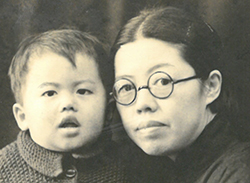 C.C. Wang as a toddler with his mother.ALL PHOTOS COURTESY OF C.C. WANG
C.C. Wang as a toddler with his mother.ALL PHOTOS COURTESY OF C.C. WANG
Wanting to help
Wang, who was born in Beijing, was a year old when the Japanese invaded China in 1937. Wang and his family escaped the invasion by roaming the countryside of southern China for nearly a decade. During this time, he contracted several infectious diseases including malaria, which brought him to the brink of death.
“I would suddenly develop a chill, which could not be relieved no matter how many blankets were placed on me,” he recalls. “That was then followed by extremely high fever. My legs would twitch, and I would fall into hallucinations followed by nightmares.”
Quinine, the preferred antimalarial treatment of the time, was difficult to obtain, and Wang was treated with the drug quinacrine, which turned his eyes yellow and partially deprived him of his hearing. After two years, the malaria disappeared on its own. Wang also suffered from typhoid, dysentery, pneumonia and various skin infections during this period.
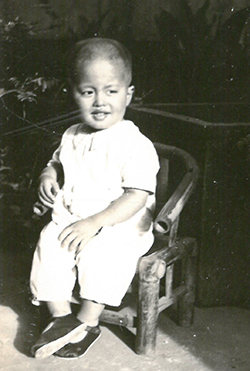 At about age 3, Wang lived in a village in southern China.
At about age 3, Wang lived in a village in southern China.
In 1949, his family settled in Taiwan, where his father taught Chinese linguistics. Wang eventually completed his bachelor’s degree in chemistry at National Taiwan University. Biochemistry had caught his attention after he attended a course on the subject taught by a visiting Chinese-American lecturer, and, in 1960, Wang was inspired to move to the U.S. to earn his Ph.D. in the subject from the University of California, Berkeley. It was during this time at Berkeley that he met his wife, Alice, who was a graduate student in molecular biology. The two were married in 1963.
After completing postdoctoral fellowships at Columbia University and Princeton University, Wang attempted to move back to China to study parasitology. He knew very little about parasitic infections but was aware of their immense human toll, especially in impoverished and rural areas.
“(Parasitic diseases) are neglected to this day. The reason is quite simple: Poor people get them, not wealthy people,” he says. This disparity has been a source of motivation throughout his career.
But Wang wasn’t able to return home. “My qualifications weren’t that great, and the councilor at the embassy said, ‘We advise you to stay in the United States, to learn more science and technology from the American imperialist. Then maybe you can consider coming back.’” Wang says, “In 1969, it was the height of the Cultural Revolution. If I had gone back then, I don’t think I would have survived.”
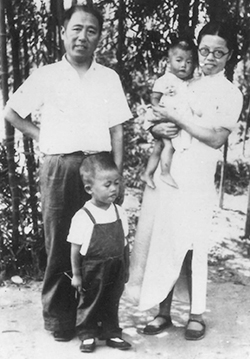 Wang, at about age 4, with his parents and younger brother near the Yangzi River in southern China.Wang contracted malaria soon after the photo was taken.
Wang, at about age 4, with his parents and younger brother near the Yangzi River in southern China.Wang contracted malaria soon after the photo was taken.
Working on animal parasites
Wang searched for a job in the American pharmaceutical industry that would allow him to focus on human parasitic diseases. Hired by the pharmaceutical company Merck to use biochemical techniques to develop new antiparasitic drugs, Wang was in for a newcomer’s shock.
“After a few days, I realized that Merck was not interested in human parasitic diseases at all,” he recalls. “What they were interested in were animal parasites — domestic animals, such as cattle, sheep, dogs — because that’s where the money is. Treating poor people, you don’t get money.”
Wang began to organize seminars and conferences about the ways in which Merck could contribute more to human health, especially parasitic infection. The events were successful, and eventually Wang was called to a meeting with the president of Merck, Lewis Saret. Saret told him that the company developing a cure that could benefit people around the world might be a good thing but Merck had an obligation to its stockholders and Wang had to remember that they were not in the business of losing money.
“After this conversation with the president, I started to quiet down and obediently work on animal parasites,” he says.
Wang was a biochemist at a time when most parasitologists still practiced 19th-century science. Research at the time was mostly descriptive and focused on where the parasites were found and in what quantity.
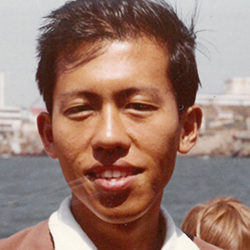 Wang first arrived in the U.S. as a graduate student at the University of California, Berkeley. Alcatraz island is in the background.
Wang first arrived in the U.S. as a graduate student at the University of California, Berkeley. Alcatraz island is in the background.
“He was a tireless and creative researcher who introduced me to the world of modern biochemistry and molecular biology,” remembers Ronald Stotish, who was Wang’s technician at Merck for many years. Stotish is now president and CEO of AquaBounty. “He kept the academic perspective of the value of basic research, even though he was in the employ of a major drug company at that time.”
Wang eventually was involved in working on nematode infections in cattle and sheep. He was part of an effort to identify natural compounds produced by soil bacteria that worked as antiparasitic therapies. But the method was crude.
Merck had set up an animal model assay in which microbiologists cultured bacteria from soil samples. They infected rats with parasitic worms and fed the bacterial cultures to the rats. They then killed and examined the rats to determine whether the parasites had been affected by the bacterial cultures. If the bacteria produced a compound that was toxic to animals, the rat died. If the rat appeared unscathed but the parasites died, the compounds might have potential as antiparasitics.
“It was a pretty stupid assay,” says Wang, adding that Merck used it for a decade. “We went through something like 150,000 soil samples. Everybody got very frustrated.”
That all changed with the discovery of ivermectin.
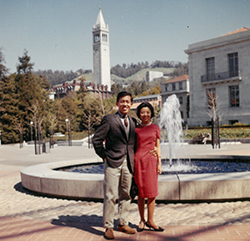 Wang with fiancee Alice at UCB.
Wang with fiancee Alice at UCB.
Ivermectin
In 1974, Merck received a shipment of 50 soil samples from the lab of Satoshi Ōmura at the Kitasato Institute in Japan. Bacteria cultured from one of these samples contained a substance called avermectin, which in its modified state is known as ivermectin. The drug would come to be known as one of the most potent antiparasitic treatments ever.
The Merck scientists screened it in the usual way by feeding it to rats. “In the first round of testing, we found activity. The second round was highly toxic. Just when we were about to abandon this thing, somebody said, ‘Well, maybe we should give it another try.’ We tried it a third time, and it turned out to be active,” says Wang. “Overnight, there were 50 chemists assigned to this project.”
At that time, Merck had a new president, P. Roy Vagelos. Vagelos wanted to understand ivermectin’s mechanism of action, hoping the details of the biochemistry and molecular biology of the molecule might assist future drug development efforts. He assigned the task of unraveling ivermectin’s mechanism of action to Wang, who described it as “a total nightmare.” He couldn’t derive a single clue about how it worked from the molecular structure.
Wang tested the compound on bacteria and worms for several years to no avail. Eventually he noticed that the middle portions of worms taken from the intestines of pigs seemed to wiggle less after being exposed to ivermectin. He eventually determined that the drug inhibits signal transmission at the neuromuscular junction in insects and at the junction between the interneuron and motor neuron in nematodes. The parasites became paralyzed and were no longer able to move.
After confirming the mechanism of action and other findings, Merck began to sell ivermectin in the U.S. as a veterinary antiparasitic drug. It quickly became a market leader, generating more than $1 billion per year in sales. Ivermectin is probably most recognizable in the U.S. as the active ingredient in the heartworm treatment Heartgard.
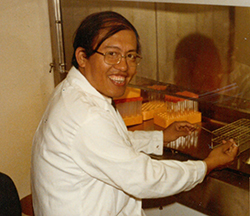 Wang working on the mechanism of action of ivermectin at Merck.
Wang working on the mechanism of action of ivermectin at Merck.
But it turned out ivermectin wasn’t just good for animals; it could do something extraordinary for people. William Campbell, now at Drew University, proposed to Merck that ivermectin be tested against river blindness in humans. River blindness is a debilitating condition caused by microscopic worms that affects hundreds of millions of people in some of the world’s poorest areas. In 1981, clinical trials began in Senegal. The trials were a success, and in 1987 Vagelos announced that his company would give the drug away for free for as long as it took to eradicate river blindness.
“After a couple of decades now, I think the disease is basically under control in West Africa,” says Wang. “There has never been a case where a pharmaceutical company has donated a drug to cure a disease where the end result is so wonderful.”
In 2015, Ōmura and Campbell shared half of the Nobel Prize in physiology or medicine for their work discovering and developing ivermectin. Ōmura was recognized for his discovery of the avermectin-containing soil sample, while Campbell was instrumental in demonstrating avermectin’s potential against parasitic worms. Wang says he would have liked to have seen Vagelos recognized as well for his decision to make the drug available free of charge.
“The world is still a very sad place,” says Wang. “But I am very happy the Nobel Prize recognized the problem and gave out the prize to ivermectin and artemisinin. At least people are starting to realize the importance of these diseases.”
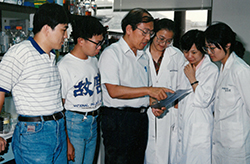 Wang in the research lab at the Institute of Molecular Biology, Academia Sinica, Taiwan.
Wang in the research lab at the Institute of Molecular Biology, Academia Sinica, Taiwan.
Freedom to pursue any project
In the late 1970s, Wang organized a monthly seminar program with other parasitologists from New York University and The Rockefeller University, two schools that were close to Merck’s New Jersey site. The seminars were followed by cocktails. In the spring of 1981, at a party that Wang described as “wild,” he was approached by two professors from UCSF. They asked if he was interested in joining the university. At that time, it was uncommon for a person to transition from industry to academia.
“I thought they were kidding, so, half-drunkenly, I said, ‘Of course, if you give me a full professorship and beat my salary at Merck!’”
But the conversation was no joke. A couple of months later, he received a phone call from the head of pharmaceutical chemistry at UCSF.
Wang transferred from Merck to the university, where he conducted research on parasites for more than 30 years. He describes this as the happiest time in his life because he had complete freedom to choose his own projects.
But the experience of working in industry gave him some perspective. “After I moved to UCSF, I realized that to discover a fantastic drug like ivermectin, you really have to be extremely lucky. In an academic setting, it would be quite difficult, because the mundane screening effort — to go through 150,000 soil samples in 10 years — you would never train any good students doing that, and the National Institutes of Health would never fund you," he says.
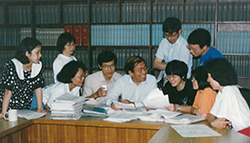 Wang working as the director of the Institute of Molecular Biology, Academia Sinica, Taiwan.
Wang working as the director of the Institute of Molecular Biology, Academia Sinica, Taiwan.
Wang focused on basic parasite research, namely regarding giardia and African trypanosomes. Giardia causes a diarrheal condition known as giardiasis, while African trypanosomes are responsible for a potentially fatal condition known as sleeping sickness.
Wang conducted research alongside his wife, Alice, who became a senior member of his laboratory at UCSF.
Alice Wang discovered a double-stranded RNA virus specific to giardia, one of the first viruses ever discovered in a parasitic protozoan. Working together over a couple of decades, the Wangs demonstrated how the microRNA machinery operates in giardia. These molecules may be primarily responsible for the expression of variant surface proteins, which could allow the parasite to elude its host’s immune response by altering its antigen profile.
Wang’s group examined the cell cycle of the African trypanosome to find that cell division operates differently depending on whether the parasite is found in the human bloodstream or within its fly host. They discovered new proteins involved in the metaphase-to-anaphase transition during cell division, which could have implications for novel antitrypanosomiasis treatments. Additionally, Wang expects these findings to contribute to understanding the evolution of eukaryotic cell division, since these protozoans represent an early branch of the eukaryotic tree of life.
 Alice Wang working in the lab at the University of California, San Francisco.
Alice Wang working in the lab at the University of California, San Francisco.
Expanding the field
As a representative for Merck, in 1979, Wang visited mainland China, where he learned about the Chinese government’s research on artemisinin. He later returned several times, teaching at universities and visiting with researchers for several months at a time until the late 1980s. But “after the Tiananmen Square massacre on June 4, 1989, I cut off all my interactions with China,” he says. “(On) subsequent visits to China, (I) wore the hat of a tourist only.”
Wang still feels a connection to Taiwan, to which he has returned many times. “Taiwan is a more democratic country, so I feel a little bit more comfortable about going back there,” he says. In 1988, he established a molecular parasitology research program at the Institute of Biomedical Sciences, Academia Sinica, and worked there for a year. In 1991, he traveled to the island with colleagues to establish the Institute of Molecular Biology at the school. He stayed for three years, eventually returning to UCSF.
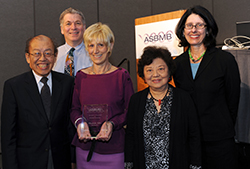 C.C. and Alice Wang with the 2012 winner of their molecular parasitology award, the late Elisabetta Ullu, along with former ASBMB presidents Jeremy Berg and Suzanne Pfeffer.
C.C. and Alice Wang with the 2012 winner of their molecular parasitology award, the late Elisabetta Ullu, along with former ASBMB presidents Jeremy Berg and Suzanne Pfeffer.
Although he retired in 2011 and is now a professor emeritus at UCSF, Wang remains invested in his field. Wang says he feels that molecular parasitology has been rejected by mainstream science despite advances in techniques and research in the field. This concern motivated him and his wife to establish the award through the ASBMB.
Looking back at his career, Wang feels lucky to have been involved in the discovery of ivermectin, which he emphasizes was the result of extensive group effort. The fervor of his youth has been rewarded: “I was very idealistic — very foolishly idealistic — when I was young, thinking that I alone could do something to save a lot of people,” he says. “I went through tremendous frustration, but somehow, through a collaboration with hundreds of people, I was able to contribute to the treatment of river blindness.”
Wang is measured in describing his contributions, but his influence on the field of parasitology has been indispensable. “He’s an intellectual force,” says Phillips, his former doctoral student. “He’s always the one at the meeting to ask the good questions, to push everybody to think about the big picture and be rigorous scientists. He’s had a huge impact on the field.”
Enjoy reading ASBMB Today?
Become a member to receive the print edition four times a year and the digital edition monthly.
Learn moreGet the latest from ASBMB Today
Enter your email address, and we’ll send you a weekly email with recent articles, interviews and more.
Latest in People
People highlights or most popular articles

Embrace your neurodivergence and flourish in college
This guide offers practical advice on setting yourself up for success — learn how to leverage campus resources, work with professors and embrace your strengths.

Survival tools for a neurodivergent brain in academia
Working in academia is hard, and being neurodivergent makes it harder. Here are a few tools that may help, from a Ph.D. student with ADHD.

Quieting the static: Building inclusive STEM classrooms
Christin Monroe, an assistant professor of chemistry at Landmark College, offers practical tips to help educators make their classrooms more accessible to neurodivergent scientists.

Hidden strengths of an autistic scientist
Navigating the world of scientific research as an autistic scientist comes with unique challenges —microaggressions, communication hurdles and the constant pressure to conform to social norms, postbaccalaureate student Taylor Stolberg writes.

Richard Silverman to speak at ASBMB 2025
Richard Silverman and Melissa Moore are the featured speakers at the ASBMB annual meeting to be held April 12-15 in Chicago.

Women’s History Month: Educating and inspiring generations
Through early classroom experiences, undergraduate education and advanced research training, women leaders are shaping a more inclusive and supportive scientific community.

